
Ferrovie dello Stato Italiane S.p.A. is Italy's national state-owned railway holding company that manages transport, infrastructure, real estate services and other services in Italy and other European countries.
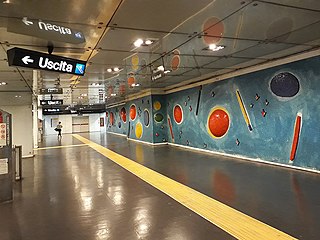
The Naples Metro is a rapid transit system serving the city of Naples, Campania, Italy and some parts of the adjacent comuni of its metropolitan area through Line 11. The system comprises four underground rapid transit lines.
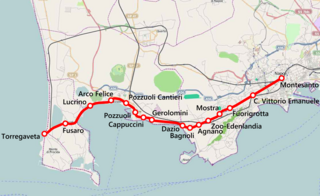
The Cumana railway is a commuter railway in Campania, southern Italy, connecting Naples by two separate routes with Torregaveta, near Cuma in the town of Bacoli. It passes through Pozzuoli and the volcanic Campi Flegrei area. The line was built and run by the Società per le Ferrovie Napoletane, founded in 1883, and is now operated by the Ente Autonomo Volturno (EAV) company.

The Italian railway system is one of the most important parts of the infrastructure of Italy, with a total length of 24,227 km (15,054 mi) as of 2011.
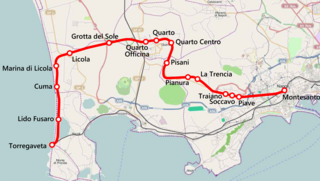
The Circumflegrea railway is a commuter railway line that connects Naples city centre with the northern Phlegraean Fields, a suburban area located west of the city. The line is operated by the Ente Autonomo Volturno (EAV) company.
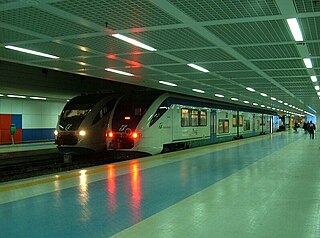
The Palermo metropolitan railway service is a commuter rail system operated by Trenitalia. It serves the city of Palermo in Sicily, Italy.

The Bari–Barletta railway is a regional railway line in Apulia, Italy, managed by the private company Ferrotramviaria.
Ferrotramviaria is a private railway company of Italy. Based in Bari, in the Apulia region, it manages the Ferrovie del Nord Barese network, composed by the Bari–Barletta railway and the Bari metropolitan railway service.
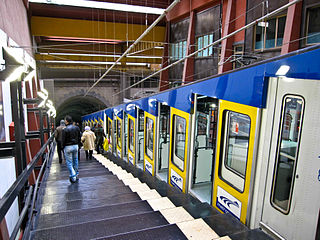
The Montesanto Funicular, is one of four operating funiculars in the public transportion system of Naples, Italy. The system is a true funicular: an inclined railway with two passenger cars connected via cables, operating in concert.
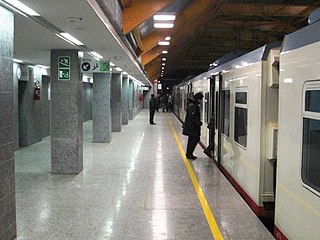
The Bari metropolitan railway service is a commuter rail service in the Italian city Bari. It consists of two lines, joining the central railway station, located in the city centre, with the dormitory suburb San Paolo and with the ″Karol Wojtyła″ Airport and the city of Bitonto.

The Adriatic railway is the railway from Ancona to Lecce that runs along the Adriatic Coast of Italy, following it almost all of the way. It is one of the main lines of the Italian rail system and links the northern cities with the most important productive areas of central and southern Italy.

A steam railcar, steam motor car (US), or Railmotor (UK) is a railcar that is self powered by a steam engine. The first steam railcar was an experimental unit designed and built in 1847 by James Samuel and William Bridges Adams in Britain. In 1848 they made the Fairfield steam carriage that they sold to the Bristol & Exeter Railway, who used it for two years on a branch line.
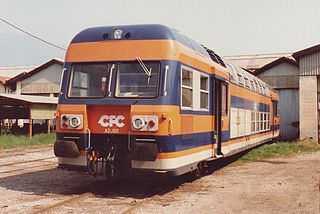
The A2n 001 was an experimental Diesel railcar built in Italy by CaFiCi consortium in 1982. Despite a long test period in several regional lines, the vehicle never came into regular service.

The Treno Servizio Regionale (TSR) are a series of double-decker EMUs used by the Lombard railway company Trenord for the commuter services around Milan, and particularly for the suburban lines.
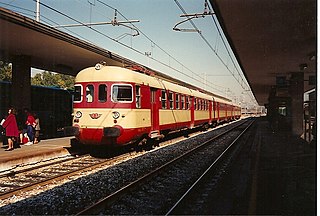
The ALe 803 are a series of EMUs built in the 1960s for the Italian state railways FS, and now used by the railway company Trenitalia.
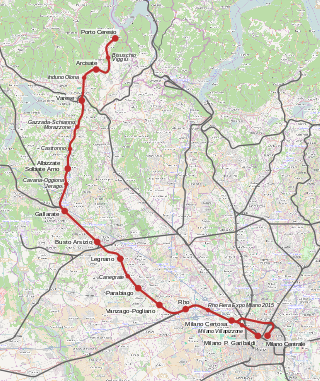
Porto Ceresio–Milan railway is a railway line in Lombardy, Italy. It uses the tracks of the Milan–Arona railway until Gallarate.

The Treviglio–Cremona railway is a railway line in Lombardy, Italy.

The ALe 724 are a class of EMUs of the Italian Ferrovie dello Stato, projected for suburban and regional services.

The Bologna–Ancona railway is an Italian railway that connects the city of Bologna with the city of Ancona, passing through the Po Valley to Rimini and along the Adriatic coast for the rest of the line.
The Ente Autonomo Volturno S.r.l., also known by the acronym EAV, is a company that operates in the sector of public transport by road, rail and cableway, in the Campania Region.
This page is based on this
Wikipedia article Text is available under the
CC BY-SA 4.0 license; additional terms may apply.
Images, videos and audio are available under their respective licenses.


















